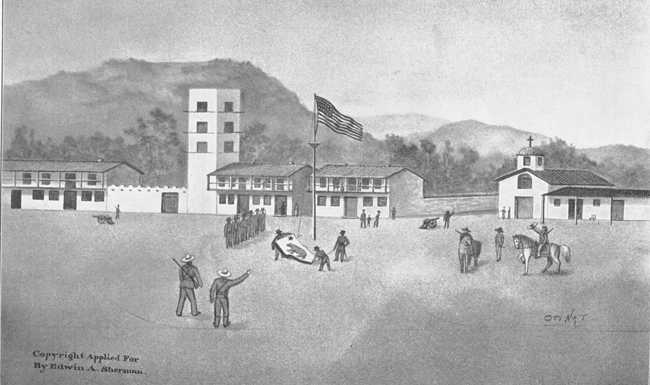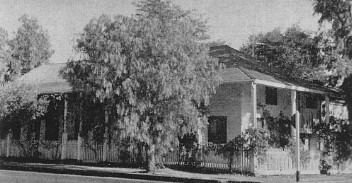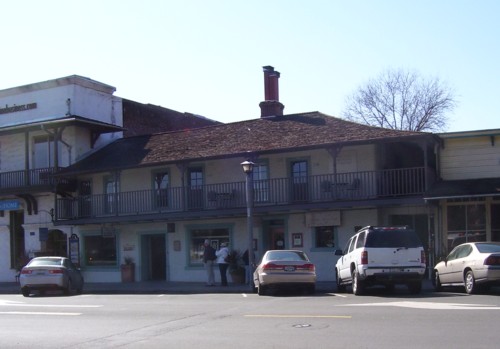

Californio soldiers under Comandante-General Mariano Vallejo drill at Sonoma. No troops were present in June, 1846 when American volunteers attached to John Fremont's force captured the town and ran up the Bear Flag.
Barracks were erected at the so-called El Presidio de Sonoma byTeniente Coronel (Lieutenant Colonel) Mariano Guadalupe Vallejo, Comandante-General of the Northern Alta California's frontier forces and founder of the town of Sonoma. In June 1846 Americans, under the banner of California's "Bear Flag," staged a brief revolt against the Mexican rulers. Reinforced a few weeks later by more troops under Commodore John D. Sloat, the force took possession of California for the United States. Navy Lieutenant Joseph W. Revere, grandson of the American Revolution hero Paul Revere, was in command for a short period. A camp -was established here on April 4, 1847, intermittently abandoned and reoccupied, and finally abandoned on October 16, 1851. A military post was established in 1852 and garrisoned for six years. Sonoma State Historical Park contains the old barracks and is located at Spain Street East and 1st Street East.
A good friend or not, as the symbol of the established government, Commandante-General Mariano Vallejo would have to be brought to terms. On that point the 33 rebels outside his house were in agreement. So before dawn on Sunday, June 14, 1846, the general and his family were awakened in their Casa Grande on the plaza of Sonoma.
Vallejo did not speak English and the guerrilla leader, Ezekiel Merritt, did hardly better in Spanish. Neither the language barrier nor early hour caused Vallejo to forget his manners, though, and he invited Merritt inside to talk. After all, Vallejo reasoned, he knew that the military barracks next door had no soldiers, and his rusted cannon had no ammunition, so what could be lose by being friendly?
Merritt's rebels lounged outside until the sun became a glowing reminder that several hours had passed. Another man was sent in but be, too, failed to return. Then, with a trap being suspected, William S. Ide volunteered to find out what was wrong and what kind of a rescue party was needed.
Ide returned in a minute. The rebels gathered around him to learn that all negotiations had been stalled by a full-scale counterattack of Vallejo's wine cellar. The affable commander had poured both freely and well, and the rebel spokesmen were too happy to do any talking, if, indeed, they remembered the reason for talking!
On these less than auspicious circumstances the California Bear Flag Revolt began. Possibly in recognition of his breaking the negotiation stalemate, the rebels elected Ide their first president. Not one to let history record a revolt without drama, Ide sent Commodore Stockton a report that provided excitement where it lacked fact:
"We charged upon the Fortress of General Guadeloupe Vallejo, and captured 18 prisoners (among whom were three of the highest officers in the California Government and all of the military officers who reside in Sonoma), eight field pieces, 200 stand of arms, a great quantity of cannon canister and grape-shot . . . the soldiers were set at liberty."
Ide's next act was to draft as a flag maker, fellow conspirator William L. Todd, nephew of Mrs. Abraham Lincoln. Todd took a yard-wide strip of unbleached muslin, bisected it with a four inch-wide strip of red, and in the top left corner drew a star and a bear. Under the stripe be painted "CALIFORNIA REPUBLIC". Before the flag was run up on June 14, the spelling of the word republic was corrected by squeezing an "I" between its last two letters.
Although Captain John C. Fremont and his exploration party were camped nearby, it does not appear that at first he was actively involved with the revolt. His sympathies obviously lay with the Americans who were reacting to rumors that Mexico was preparing to oust all foreigners from California. When two men were tortured and killed, Fremont assumed that the Mexicans were to blame. He actively joined the revolt, but first going through the formality of mailing his resignation to Washington. Joining with Fremont was Marine Captain Archibald Gillespie, unaccountably with Fremont although supposedly on some type of courier mission.
The Bear Flag Revolt lasted 26 days. Its short-lived history was marred by several unnecessary deaths and illegal seizures of private property, but it had one redeeming factor. Off of Monterey lay the flagship of indecisive Commodore Sloat; news that a revolt was in progress finally caused him to land troops and proclaim the annexation of California.
The removal of the Bear Flag was assigned almost ironically to Navy Lieutenant Joseph W. Revere, grandson of Paul Revere of Revolutionary War fame. Sent from USS Portsmouth, Lieutenant Revere raised the Stars and Stripes in Sonoma on July 9, 1846, and "all hands gave up to an excess of joy," Seaman Joseph T. Downey remembered:
"Bells were rung, guns fired, whisky barrel tapped, and hilarity became the order of the day."
Revere returned to Sonoma on August 1 to command the American forces. He stayed during the fall, 1846, as one of Commodore Stockton's land-bound Naval officers.


Sonoma's double storied adobe barracks became the home for various contingents of United States soldiers, sailors, and militiamen. Volunteer Captain John E. Brackett was in command in 1847 when Alcalde John H. Nash refused to surrender his justice-of-the-peace-type position to Lilburn W. Boggs. This was a direct challenge to the authority of the Colonel Richard B. Mason, the military governor. Brackett asked to be excused from forcing the issue; be said that the people who favored Nash might take revenge when Brackett left the service and settled in Sonoma.
Mason's reaction to this excuse was described as "wrath" by Lieutenant William T. Sherman who was sent to Sonoma to correct the situation. Accompanied by six sailors and Navy Lieutenant Louis McLane, Sherman arrived at Sonoma and easily found Nash. Any thought the deposed alcalde had of resisting evaporated when one of the sailors, inexperienced with hand guns, accidentally and harmlessly fired his pistol.
Several days later a bedraggled and seasick Nash arrived at Mason's Monterey headquarters. When Mason kindly explained the facts of life and told him "to go and sin no more," Nash eagerly agreed. His return to Sonoma to assist Boggs in assuming the alcalde duties marked the end of resistance in that area to American authority.
TO GET THERE: Sonoma is about 45 miles north of San Francisco via U.S. 101, and state 37 and 121. Barracks is in the plaza at Spain Street East and 1st Street East. Leese-Fritch House is at 493 1st Street West and Ray House at 209 Spain Street East.

Possession taken by Lieutenant Joseph Warren Revere, USN, at 12 am, July 9, 1846, by order of Commodore John Drake Sloat, USN. Mexican Captain Salvador Vallejo's quarters are seen at the left, Lieutenant Colonel Mariano Guadalupe Vallejo's headquarters, left of center, barracks, center, and the Old Mission, right.

Sonoma Plaza, 1851, was drawn by George Gibbs. Capitan (Captain) Salvador Vallejo, brother of Lieutenant Colonel Vallejo, occupied house at far left; general's Casa Grande or Comandancia, center, was complete with a several-story wing from which he could oversee range lands and farms through a telescope. The Baracas (Barracks) were to the left of the flagpole, a former mission behind pole, and shops to right. When Bear Flag rebels attacked Sonoma, they expected 80 to 100 soldiers and 200 Indians would be in garrison but "when the charge was made . . . there was no resistance, simply because there was no one to resist," said one report.

Sonoma Barracks was built in 1830's by Teniente Coronel (Lieuteant Colonel) Mariano Guadalupe Vallejo, Comandante-General of the Northern Frontier of Alta California, as key to Mexico's strategy to stop Russian spread into California. At right of barracks can be seen edge of Mission San Francisco de Solana, northernmost California mission and only one founded under Mexican rule. A wooden mission structure 24 by 105 feet when built in 1823, it was replaced by adobe building in 1840. Despite secularization order in 1834, Vallejo kept chapel active as a garrison church and local parish.

William T. Sherman lived here when stationed in Sonoma in 1849. Known as Ray House and also Adler Adobe, double-story frame and adobe residence served as officers mess until Army left Sonoma in 1852. It was also site of Masonic Lodge organized by several officers of garrison. Sailors stationed at Sonoma in 1846 were supplied by boats from San Francisco. Mystery still shrouds one boat that completely disappeared during trip with loss of 10-man crew, including two sons of USS Portsmouth's captain.

The U.S. Army's Pacific Division was headquartered in this building, the Leese-Fritch House. General Persifor Smith coordinated affairs of California and Oregon Departments from here 1849-50. The California Department was headquartered here for two months in 1850. Sherman's replacement as adjutant general here, Major Joseph Hooker, soon resigned to become Sonoma farmer and beachcomber. Legend has it that his associates here and later as Civil War general caused his lost name to become slang term for certain class of women of questionable repute. (2009, Dan Sebby)

This page was reprinted with permission from Pioneer Forts of the Far West, published in 1965